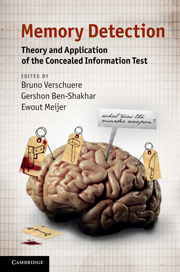Book contents
- Frontmatter
- Contents
- List of figures
- List of tables
- Notes on contributors
- Acknowledgments
- Part I Introduction
- Part II The laboratory: theoretical and empirical foundations of the Concealed Information Test
- Part III Field applications of concealed information detection: promises and perils
- 8 Limitations of the Concealed Information Test in criminal cases
- 9 Validity of the Concealed Information Test in realistic contexts
- 10 Leakage of information to innocent suspects
- 11 Countermeasures
- 12 Psychopathy and the detection of concealed information
- 13 Clinical applications of the Concealed Information Test
- 14 Daily application of the Concealed Information Test: Japan
- 15 The Concealed Information Test in the courtroom: legal aspects
- Part IV Conclusions
- Index
- References
14 - Daily application of the Concealed Information Test: Japan
Published online by Cambridge University Press: 05 June 2012
- Frontmatter
- Contents
- List of figures
- List of tables
- Notes on contributors
- Acknowledgments
- Part I Introduction
- Part II The laboratory: theoretical and empirical foundations of the Concealed Information Test
- Part III Field applications of concealed information detection: promises and perils
- 8 Limitations of the Concealed Information Test in criminal cases
- 9 Validity of the Concealed Information Test in realistic contexts
- 10 Leakage of information to innocent suspects
- 11 Countermeasures
- 12 Psychopathy and the detection of concealed information
- 13 Clinical applications of the Concealed Information Test
- 14 Daily application of the Concealed Information Test: Japan
- 15 The Concealed Information Test in the courtroom: legal aspects
- Part IV Conclusions
- Index
- References
Summary
Overview: Japan is the only country in the world where the Concealed Information Test (CIT) is applied on a large scale. In Japan, approximately 5,000 examinations are conducted annually by about 100 professional examiners. This chapter provides a detailed description of how those examinations are conducted, from the request for the examination to the report of the result. Procedural aspects such as generating the questions are illustrated with real-life examples. Finally, I discuss the current status of the CIT in Japan and some future prospects of the CIT.
Japan is the only country in the world where the Concealed Information Test (CIT) is applied on a large scale. Furthermore, the CIT is the only polygraph technique used in Japan, as the Control Question Test (CQT) is no longer applied. Polygraph examiners in Japan carry out the CIT on a daily basis. Throughout the country, about 5,000 examinations are conducted annually. These are performed by professional examiners assigned in each prefecture. This chapter provides a detailed description of how the polygraph examination is conducted in Japan, and why the CIT is successfully utilized in Japan.
Examiner
There are about 100 examiners in Japan. All examiners are assigned to a forensic science laboratory of a prefectural police headquarters. Typically the polygraph examiners belong to the psychological evidence section of their forensic science laboratories. The laboratory staff does not consist of police officers but of technical officers, who are also engaged in research.
Information
- Type
- Chapter
- Information
- Memory DetectionTheory and Application of the Concealed Information Test, pp. 253 - 275Publisher: Cambridge University PressPrint publication year: 2011
References
Accessibility standard: Unknown
Why this information is here
This section outlines the accessibility features of this content - including support for screen readers, full keyboard navigation and high-contrast display options. This may not be relevant for you.Accessibility Information
- 49
- Cited by
